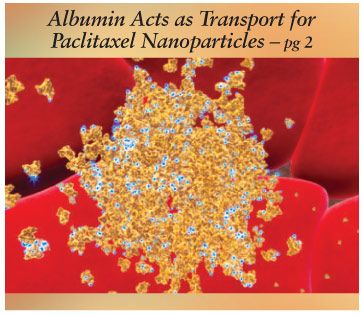Nab-Paclitaxel Bests Docetaxel in First-Line Met Breast Ca
Nanoparticle albumin-bound paclitaxel (nab-paclitaxel, Abraxane) given weekly outperformed docetaxel (Taxotere) given every 3 weeks as first-line treatment of metastatic breast cancer.
SAN ANTONIONanoparticle albumin-bound paclitaxel (nab-paclitaxel, Abraxane) given weekly outperformed docetaxel (Taxotere) given every 3 weeks as first-line treatment of metastatic breast cancer. William Gradishar, MD, director of Medical Breast Oncology at the Robert H. Lurie Comprehensive Cancer Center, Northwestern University, reported the results of the phase II study at the recent 29th Annual San Antonio Breast Cancer Symposium (abstract 46).

The study compared three treatments among 300 postmenopausal patients with no prior chemotherapy for metastatic disease: nab-paclitaxel 300 mg/m2 given every 3 weeks, nab-paclitaxel 100 mg/m2 or 150 mg/m2 dosed weekly for 3 out of 4 weeks, and docetaxel 100 mg/m2 given every 3 weeks. The study assessed three issues: nab-paclitaxel vs docetaxel, weekly vs every 3-week dosing of nab-paclitaxel, and high vs low doses of nab-paclitaxel.
At a planned interim analysis in July 2006, responses had been assessed in 210 patients (70%), with 59 confirmed responses. Nab-paclitaxel given weekly at 100 or 150 mg/m2, compared with docetaxel given every 3 weeks, resulted in significant improvements in response rates.
Response rates were 61% higher with nab-paclitaxel 100 mg/m2 (58% vs 36%; P = .004) and 72% higher with the 150 mg/m2 dose (62% vs 36%; P = .0016), compared with docetaxel. Response rates for nab-paclitaxel every 3 weeks were comparable to those of docetaxel and significantly lower than those of weekly nab-paclitaxel. While only a third of potential events have occurred to date, all three nab-paclitaxel arms had longer progression-free survivals vs docetaxel. "Because of these encouraging results, a blinded independent radiology review of the response data is currently being conducted," Dr. Gradishar said.
Compared with docetaxel, all three nab-paclitaxel arms were associated with less frequent adverse events, especially:
- Grade 4 neutropenia (74% docetaxel vs 3% to 7% with nab-paclitaxel).
- Febrile neutropenia (7% with docetaxel vs 1% with nab-paclitaxel).
- Grade 1 and 2 mucositis/stomatitis (20% with docetaxel vs 0% to 3% with nab-paclitaxel).
No grade 4 peripheral neuropathy was reported in any of the treatment arms, and there were no significant differences among the arms for any-grade peripheral neuropathy. Arthralgias were less frequent with the lower nab-paclitaxel dose but more frequent with the other two nab-paclitaxel arms vs docetaxel. Fatigue was significantly lower with nab-paclitaxel vs docetaxel (21% vs 46%).
"These interim data show that weekly nab-paclitaxel used in the first-line metastatic setting increased responses by over 60%, with less toxicity than the FDA-approved dose of docetaxel given every 3 weeks," Dr. Gradishar said.
Data from the trial were intended to provide direction for the design of future trials of nab-paclitaxel. Abraxis Bioscience Inc. plans to initiate a worldwide head-to-head phase III registration trial comparing weekly nab-paclitaxel 100 mg/m2 (with no standard premedication) to every-3-week docetaxel 100 mg/m2 (with premedication) in the first-line treatment of metastatic breast cancer. Planned enrollment is 1,000 patients.